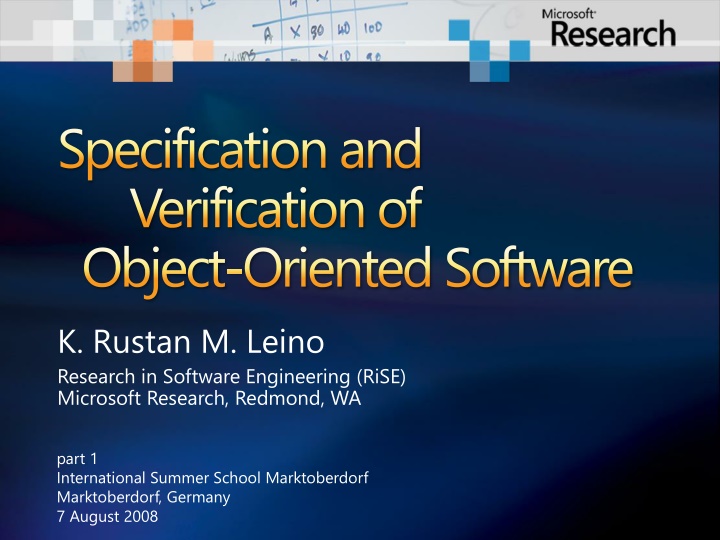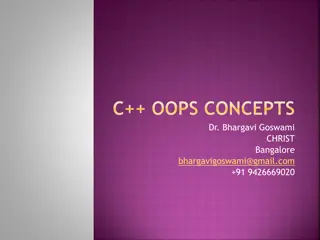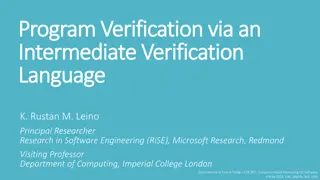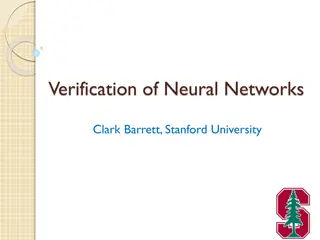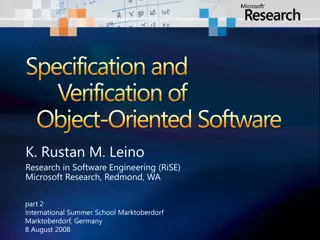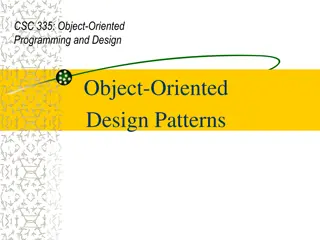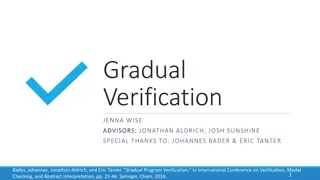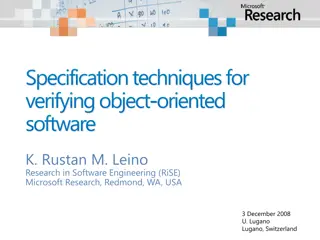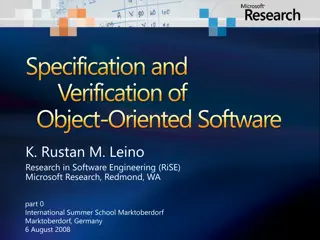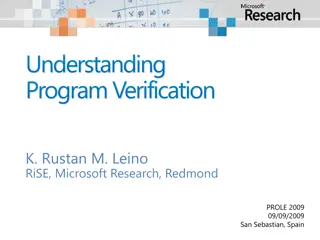Specification and Verification of Object-Oriented Software
This content delves into the specification and verification of object-oriented software, exploring concepts like basic verifier architecture, command language, and reasoning about execution traces using Hoare triple. It discusses the relationship between starting states, terminations, and satisfying conditions in software verification.
Download Presentation

Please find below an Image/Link to download the presentation.
The content on the website is provided AS IS for your information and personal use only. It may not be sold, licensed, or shared on other websites without obtaining consent from the author.If you encounter any issues during the download, it is possible that the publisher has removed the file from their server.
You are allowed to download the files provided on this website for personal or commercial use, subject to the condition that they are used lawfully. All files are the property of their respective owners.
The content on the website is provided AS IS for your information and personal use only. It may not be sold, licensed, or shared on other websites without obtaining consent from the author.
E N D
Presentation Transcript
Specification and Verification of Object-Oriented Software K. Rustan M. Leino Research in Software Engineering (RiSE) Microsoft Research, Redmond, WA part 1 International Summer School Marktoberdorf Marktoberdorf, Germany 7 August 2008
Basic verifier architecture Source language Intermediate verification language Verification condition (logical formula)
Command language x := E x := x + 1 assert P P P assume P x := 10 P havoc x Solid lines indicate traces whose length is 1 Dotted lines indicate traces whose length may be greater than 1
Command language S ; T Solid lines indicate traces whose length is 1 Dotted lines indicate traces whose length may be greater than 1
Command language x := E x := x + 1 assert P P P assume P x := 10 P havoc x S T S ; T Solid lines indicate traces whose length is 1 Dotted lines indicate traces whose length may be greater than 1
Reasoning about execution traces Hoare triple every terminating execution trace of S that starts in a state satisfying P does not go wrong, and terminates in a state satisfying Q Given P and Q, what is the largest S satisfying {P} S {Q} ? to check {P} S {Q}, check S S { P } S { Q } says that
Reasoning about execution traces Hoare triple every terminating execution trace of S that starts in a state satisfying P does not go wrong, and terminates in a state satisfying Q Given S and Q, what is the weakest P satisfying {P } S {Q} ? P' is called the weakest precondition of S with respect to Q, written wp(S, Q) to check {P} S {Q}, check P P { P } S { Q } says that
Reasoning about execution traces Hoare triple every terminating execution trace of S that starts in a state satisfying P does not go wrong, and terminates in a state satisfying Q Given P and S, what is the strongest Q satisfying {P} S {Q } ? to check {P} S {Q}, check Q' Q not well defined { P } S { Q } says that For example, what is the strongest Q satisfying { true } assert false { Q } ? (there isn t one)
Checking correctness with sp { x < 10 } x := x + 1; assert P(x); x := x + 1 { true } sp( x < 10, x := x + 1 ) = x 10 need to check the assert: x 10 P(x) sp( x 10, assert P(x) ) = x 10 P(x) sp( x 10 P(x), x := x + 1 ) = x 11 P(x-1) check: x 11 P(x-1) true
Checking correctness with wp { x < 10 } x := x + 1; assert P(x); x := x + 1 { true } = wp( x := x + 1, true ) = wp( assert P(x), true ) = wp( x := x + 1, P(x) ) check: x < 10 P(x+1) true P(x) P(x+1)
Advanced: wp, wlp, sp, Galois sp treats assert as it treats assume wlp is like wp but treats assert as assume wlp and sp form a Galois connection: [spS(P) Q] [P wlpS(Q)] lower adjoint upper adjoint one adjoint uniquely determines the other an upper adjoint is universally conjunctive wp is not univerally conjunctive so, wp has no lower adjunct that is, there is no function f such that [f(P) Q] [P wpS(Q)] (wpassert false(true) true)
Weakest preconditions For any command S and post-state predicate Q, wp(S,Q) is the pre-state predicate that characterizes those initial states from which every terminating trace of S: does not go wrong, and terminates in a state satisfying Q wp( x := E, Q ) = wp( havoc x, Q ) = wp( assert P, Q ) = wp( assume P, Q ) = wp( S ; T, Q ) = wp( S T, Q ) = Q[ E / x ] ( x Q ) P Q P Q wp( S, wp( T, Q )) wp( S, Q ) wp( T, Q )
Command correctness A command S is correct iff wp(S, true) is valid
Structured if statement if E then S else T end = assume E; S assume E; T
Dijkstra's guarded command if E S | F T fi = assert E F; ( assume E; S assume F; T )
Picking any good value assign x such that P = havoc x; assume P P ; = P Example: assign x such that x*x = y What if we want assign to be total? assert ( x P); havoc x; assume P
Definedness of expressions x := a / b assert b 0; x := a / b x := a + b assert -231 a + b; assert a + b < 231; x := a + b x := a + b x := PlusWrap(a, b) // possible div-by-0 // possible overflow // use modular arith.
Complex data values: Arrays An array is a map from indices to values array update is map update: a[ j ] := E means a := a[ j E ] apply/select/get/rd and update/store/set/wr follow the familiar properties: ( a,j,k,x j = k a[ j x ][ k ] = x ) ( a,j,k,x j k a[ j x ][ k ] = a[ k ] )
While loop with loop invariant while E invariant J do S end = ?
